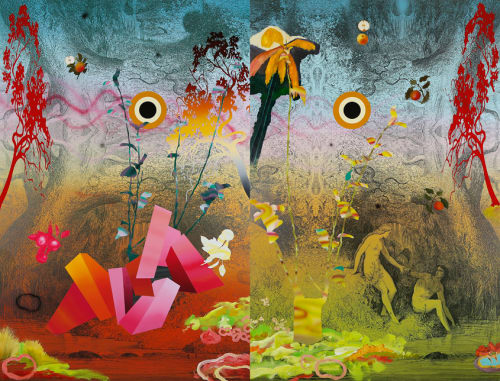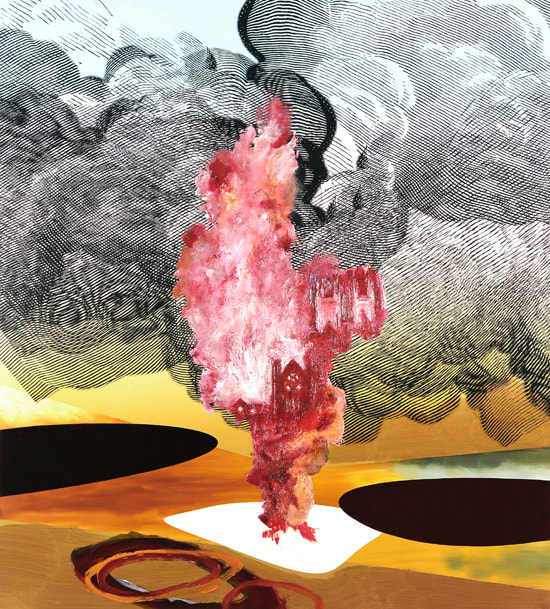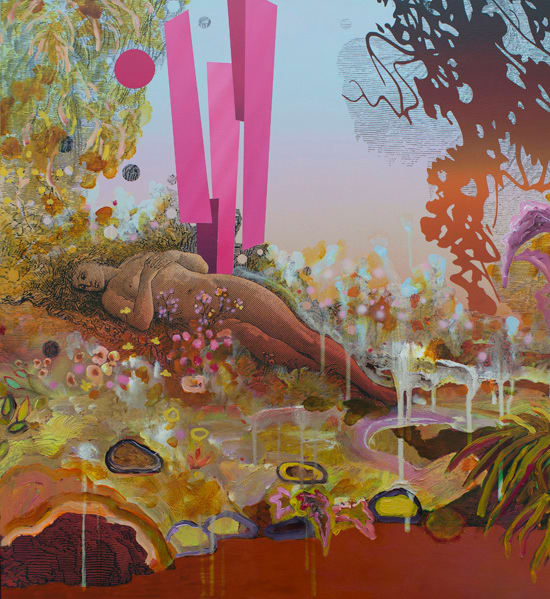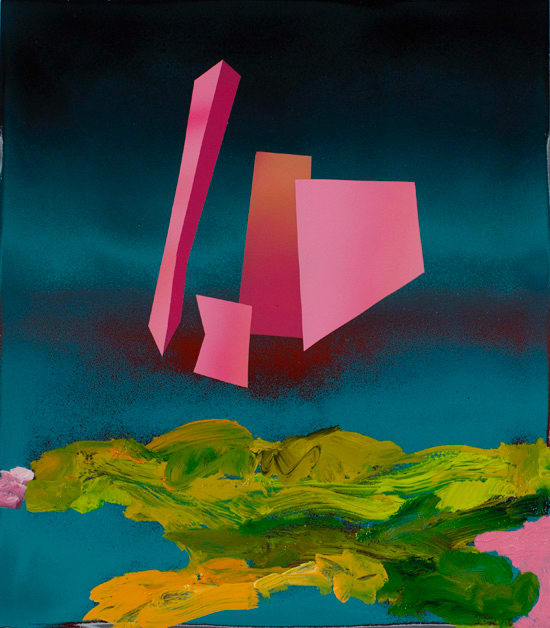anecdote / shift / mirror
Neil Haddon's recent paintings draw on his experience as a migrant to Tasmania and the ways that migrants find their own poetic meaning in the unfamiliar contexts of a new home.
Haddon employs a collage-like approach to painting, using a variety of seemingly incongruous sources. Collage is interpreted broadly as the combination of different things to make a new whole. Haddon proposes that collage can be understood as movement and relocation, fragmentation and recombination, slippage in meaning and innovative translation. In these paintings, meaning is in flux and is renegotiated according to the diverse cultural influences of where we come from and where we find ourselves now. The viewer is free to consider how meaning is made when the supporting contexts for that imagery are strange to us.
The paintings are made with a variety of materials and processes bringing together fragments of artworks by Gustave Doré, Paul Gauguín and John Glover in abstracted constructions to picture a state of flux where significance and association are perpetually renegotiated according to the influences of an old place and the new place.
Why these fragments? Haddon tells an anecdote about how Gauguín’s Mata Mua (1892) was present at two significant moments of dislocation in his life, decades apart (once in Madrid and once in New York), and how that painting became a way marker of his own Gauguín-like search for exotic encounter. Mata Mua is itself a re-combination of elements rather than a representation of a real scene; it is more a picture of what Gauguín wanted to see instead of what he actually found. Scenes of the Epsom Derby from Doré’s illustrations for London: A Pilgrimage (1872) serve as a way of evoking Haddon’s birthplace, whilst illustrations from Paradise Lost (1866) function as a depiction of an idealised, fictional landscape. A stylised adaptation of a tree from Glover’s A corrobery of natives in Mills Plains (1832) is reiterated and repeated, flipped and mirrored across multiple paintings as a questionable icon of place. That all of these sources should come from the 19th Century suggests not only a historical distance but also a distance in emotive connection as the migrant returns to the place of origin only to find it unalterably changed.
The exhibition is entitled ‘anecdote / shift / mirror’. All three words (both noun and verb) describe a state or an action that apply to the processes of migratory meaning making.
-
 Neil HaddonWe bring our own fruit, 2017oil, enamel and digital print on aluminium panel180 x 240 cm diptychSold
Neil HaddonWe bring our own fruit, 2017oil, enamel and digital print on aluminium panel180 x 240 cm diptychSold -
 Neil HaddonWe can build it anew, 2017oil and enamel paint on aluminium panels192 x 168 cmSold
Neil HaddonWe can build it anew, 2017oil and enamel paint on aluminium panels192 x 168 cmSold -
 Neil HaddonBring your own, 2017acrylic and oil on canvas153 x 137.5 cmAU$ 12,000.00
Neil HaddonBring your own, 2017acrylic and oil on canvas153 x 137.5 cmAU$ 12,000.00 -
 Neil HaddonWe will work together, 2017acrylic on canvas137.5 x 122 cmAU$ 10,000.00
Neil HaddonWe will work together, 2017acrylic on canvas137.5 x 122 cmAU$ 10,000.00 -
 Neil HaddonWe’ll make our own mistakes, 2017acrylic and oil on canvas137.5 x 122 cmSold
Neil HaddonWe’ll make our own mistakes, 2017acrylic and oil on canvas137.5 x 122 cmSold -
 Neil HaddonBuilding blocks, 2016oil and enamel paint on aluminium panel71 x 70 cmSold
Neil HaddonBuilding blocks, 2016oil and enamel paint on aluminium panel71 x 70 cmSold -
 Neil HaddonOur houses will burn, 2017oil and enamel paint on aluminium panel60 x 54 cmSold
Neil HaddonOur houses will burn, 2017oil and enamel paint on aluminium panel60 x 54 cmSold -
 Neil HaddonI am building an island, 2016oil and enamel paint on aluminium panel60 x 50 cmSold
Neil HaddonI am building an island, 2016oil and enamel paint on aluminium panel60 x 50 cmSold -
 Neil HaddonA sheltered home, 2016oil and enamel paint on aluminium panel62 x 52 cmAU$ 4,500.00
Neil HaddonA sheltered home, 2016oil and enamel paint on aluminium panel62 x 52 cmAU$ 4,500.00 -
 Neil HaddonL’isola disabitata, 2016oil and enamel paint on aluminium panel63 x 54 cmSold
Neil HaddonL’isola disabitata, 2016oil and enamel paint on aluminium panel63 x 54 cmSold -
 Neil HaddonMonument, 2016oil and enamel paint on aluminium panel60 x 61 cmAU$ 4,500.00
Neil HaddonMonument, 2016oil and enamel paint on aluminium panel60 x 61 cmAU$ 4,500.00 -
 Neil HaddonWe’ll bring our sex, 2017oil and enamel paint on aluminium panel60 x 54 cmSold
Neil HaddonWe’ll bring our sex, 2017oil and enamel paint on aluminium panel60 x 54 cmSold -
 Neil HaddonWe can build new houses, 2017oil and enamel paint on aluminium panel66 x 60 cmSold
Neil HaddonWe can build new houses, 2017oil and enamel paint on aluminium panel66 x 60 cmSold -
 Neil HaddonTerra firma, 2016oil and enamel paint on aluminium panel43 x 37 cmSold
Neil HaddonTerra firma, 2016oil and enamel paint on aluminium panel43 x 37 cmSold















